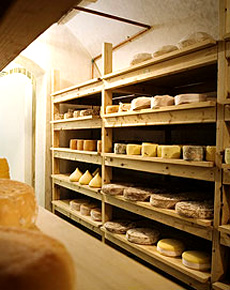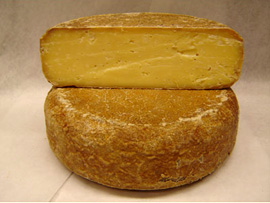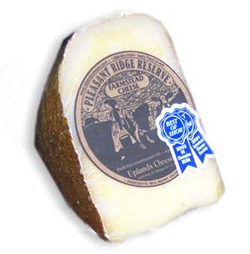

The affinage cave at Murray’s Cheese in New York City, one of the country’s finest cheesemongers.
|
STEPHANIE ZONIS focuses on good foods and the people who produce them. Click here to contact her.
|
|
September 2006
|
 |
Whey To Go ~ September 2006
Your Local Cheesemonger
Pleasant Ridge Reserve
My name is Stephanie Zonis, and welcome to Whey to Go! for September, 2006. Every month, we’ll delve into a new cheese-related subject, and I’ll offer a recommendation on a cheese I love.
Support Your Local Cheesemonger: A Brief Guide To The Specialty Cheese Seller
You can run, but you cannot hide. Cooler weather and (gasp!) the holiday season are nearly upon us once more. With the upcoming holiday and party season, no doubt your thoughts are turning to cheese. Cheese for parties, gifts, recipes, or as a nibble to have around the house when friends and family invade—um, I mean, gather.
But how do you buy your cheese? Gentle reader, if you are content to plunge into the chaos of the nearest supermarket’s cheese counter and snap up the first plastic-wrapped wedge of Cheddar you see, I say, fie for shame! As with everything we consume, the purchase of cheese should require a bit of the cognitive process. Pause for a moment or two to reflect upon what you’re placing in your grocery cart. Is it really the best choice to go with that California merlot, or for your nearly world-famous cheese-and-garlic toast?
If you feel lost when contemplating the multitude of cheeses available to consumers these days, you’re not alone. But how can you choose a cheese unknown to you with any certainty? Enter one of the lactophile’s best friends—the cheesemonger.
- What exactly is a cheesemonger? The short answer is that he or she is a specialist in cheeses—their selection, characteristics, purchasing, storing, and sometimes their aging. Typically, you’ll find a cheesemonger in a cheese shop or the cheese section of a specialty foods store (occasionally, an upscale supermarket will employ a genuine cheesemonger, too). One can’t just become a cheesemonger overnight; some formal education is usually required, as well as considerable experience in working with cheeses.
- Why are cheesemongers so useful? A knowledgeable, enthusiastic cheesemonger makes a wonderful guide to the sometimes mystifying world of cheeses. He or she can help you match cheeses with wines (or beers!), find something new that you really like, or recommend cheeses for a cheese plate or gift.
But just because someone sets up a cheese shop or is in charge of a cheese department, it doesn’t mean they’re either knowledgeable or enthusiastic. How do you know? It helps if you’re aware of a few things to check for. It isn’t necessary to ask to see a cheesemonger’s diploma, but take a good look around when you go into the store or cheese area.
- If all you see are pre-cut, plastic-wrapped wedges, go elsewhere! In this day and age, when convenience and speed are over-emphasized, it’s almost mandatory that even the best cheese retailer will have to stock some pre-cut wedges, due to consumer demand. But what you’re looking for are uncut or partially-cut wheels, a sign that this retailer will cut a cheese to your specifications. As a rule, pre-cut wedges of cheese dry out much more quickly than cheese that’s still part of a wheel or block.
Speaking of those wheels, look at the cut side of some of them.
- Do they look dried out, especially at the edges, or are they still fresh-looking and appetizing? Are there cracks in the exteriors of the wheels? You want fresh-looking cheeses, not those that seem dried out, and exterior cracks in wheels are to be avoided at all costs, as they indicate improper handling or storage.
- Is there mold on the cut side of any wheels? While mold on the exterior of a cheese is often a very good sign, unless the cheese is one of the blue family, or one of a handful that occasionally develop interior mold (such as Cheddar), there shouldn’t be mold on the interior surface of a cheese. Pick up a few of those pre-cut wedges and sniff them. While some cheeses naturally have a strong or earthy aroma, you should not smell ammonia, a scent typical of an overripe cheese or one that’s been poorly cared for.
Talk to the cheesemonger.
- Is he or she willing to answer any questions you may have? Does the cheesemonger make specialized suggestions when you ask about gifts, or pairing the cheese with wine or other foods? (“That wine would go well with a bleu cheese” might be O.K., but “That wine would go well with this creamy bleu from Oregon, which isn’t too strong but will still stand up to the wine’s flavor,” is much better.)
- Can the cheesemonger tell you which cheeses are in season (yes, some cheeses go in and out of season!)?
- Does he or she offer tastes of suggested cheeses? Tasting a cheese you’re thinking about buying is very important. You’ll likely pay more money for cheese at a specialty foods store or cheese shop; you trust that they’ll have good-quality, properly handled and stored cheeses and can impart some knowledge. You won’t like every cheese in this world, so if you’re going to fork over significant cash for a chunk of an artisanal aged sheep’s milk, it’s a great advantage to be able to try it first. This isn’t possible with every cheese (some are sold in small, whole wheels and really can’t be cut without rendering them unsaleable), but it can be done with many. And it’s O.K. to ask to taste a cheese if the cheesemonger doesn’t offer to let you do so.
- Pay attention, too, when your cheese is cut and wrapped. What kind of wrapping does the cheesemonger use? Plastic wrap, seen so frequently at the supermarket cheese counter, can suffocate a cheese, causing loss of good flavor and texture. Butcher paper or heavy-duty waxed paper are usually better for preserving cheese quality. And how about follow up? Does the cheesemonger give you specific instructions for storing and serving the cheese? Both are important for preserving cheese quality and showing off the cheese you’ve so carefully selected to its best advantage.
If something about a particular cheesemonger doesn’t suit you, or you’re put off by something he or she does or doesn’t do, remember that cheesemongers, like people, are all going to be different. You may have to do a little shopping around before you find one you like and with whom you’re comfortable. If you simply don’t have a cheesemonger near you, or can’t find one with whom you’re comfortable, all may not be lost. As has been mentioned, some upscale markets have decent cheese sections, although knowledge may vary from employee to employee. Many Whole Foods Markets are decent places to buy cheese, and the East Coast chain Wegman’s does fairly well, too, though I’d rather support a small, area business if possible.
While the number and variety of cheeses available today can lead to much anxious hand-wringing, one of your best guides through this jungle can be an informed, ardent specialty retailer. Support your local cheesemonger, and be confused no more.
Cheese Of The Month: Pleasant Ridge Reserve
Uplands Cheese Company, of Dodgeville, Wisconsin, produces Pleasant Ridge Reserve, which is surely one of the great “American originals”—although it is inspired by farmstead cheeses from the alpine provinces of southeastern France. This artisan cheese is made by cheesemaker Mike Gingrich from the non-pasteurized milk of a single herd of Wisconsin cows, which is fed and managed using natural, “old world” practices. The cows graze on lush pastures from early spring through fall, just as all cows did before the industrialization of our food system. The aging techniques used were originally developed in the Middle Ages, when cheeses similar to Pleasant Ridge Reserve were aged in limestone caves and washed frequently with a brine solution. Washing the rind keeps it free of unwanted microbes and produces a variety of pleasing flavors. Because of the time-consuming hand work involved this practice is rarely used today. The cheese then spends about 4 months in the aging room. The “Extra Aged,” shown below, is matured for 12 to 18 months, intensifying its flavors, especially the sweetness.
This cheese is equally at home with fruit and bread, paired with wine, or used in recipes; it’s truly multi-purpose. Its semi-hard texture means that you can slice, cube, or grate it. It’s got a great “melt,” for those of you who understand that grilled cheese sandwiches are much improved without that funny-colored orange stuff between the bread slices.
 Better still, Pleasant Ridge Reserve has an aroma and a flavor both kids and adults will enjoy. It isn’t a “stinky” cheese, nor is its flavor very strong, but don’t get the idea that it’s bland; nothing could be further from the truth. What’ll you get with this beautiful raw milk product is layer upon layer of truly complex tastes. The cheese is vaguely Gruyere-like, and the interior “paste,” as it’s called, is roughly a similar hue, yet Pleasant Ridge Reserve has a unique flavor and character. Luckily for cheese-lovers everywhere, this is not a difficult cheese to obtain. Better still, Pleasant Ridge Reserve has an aroma and a flavor both kids and adults will enjoy. It isn’t a “stinky” cheese, nor is its flavor very strong, but don’t get the idea that it’s bland; nothing could be further from the truth. What’ll you get with this beautiful raw milk product is layer upon layer of truly complex tastes. The cheese is vaguely Gruyere-like, and the interior “paste,” as it’s called, is roughly a similar hue, yet Pleasant Ridge Reserve has a unique flavor and character. Luckily for cheese-lovers everywhere, this is not a difficult cheese to obtain.

Pleasant Ridge Reserve |
Pleasant Ridge Reserve was awarded Best of Show at the 2005 American Cheese Society conference, an award it won in 2001 as well. It was named U.S. Champion at the 2003 U.S. Championship cheese contest—the only cheese to ever win both national competitions.
Surf over to UplandsCheese.com; you can also find it at Zingerman.com and DiBruno.com. MurraysCheese.com has the Pleasant Ridge Reserve Extra-Aged, shown above. This is a great choice to have around the house any time of year.
|
Lifestyle Direct, Inc. All rights reserved. Images are the copyright of their respective owners. 
|





 Better still, Pleasant Ridge Reserve has an aroma and a flavor both kids and adults will enjoy. It isn’t a “stinky” cheese, nor is its flavor very strong, but don’t get the idea that it’s bland; nothing could be further from the truth. What’ll you get with this beautiful raw milk product is layer upon layer of truly complex tastes. The cheese is vaguely Gruyere-like, and the interior “paste,” as it’s called, is roughly a similar hue, yet Pleasant Ridge Reserve has a unique flavor and character. Luckily for cheese-lovers everywhere, this is not a difficult cheese to obtain.
Better still, Pleasant Ridge Reserve has an aroma and a flavor both kids and adults will enjoy. It isn’t a “stinky” cheese, nor is its flavor very strong, but don’t get the idea that it’s bland; nothing could be further from the truth. What’ll you get with this beautiful raw milk product is layer upon layer of truly complex tastes. The cheese is vaguely Gruyere-like, and the interior “paste,” as it’s called, is roughly a similar hue, yet Pleasant Ridge Reserve has a unique flavor and character. Luckily for cheese-lovers everywhere, this is not a difficult cheese to obtain. 